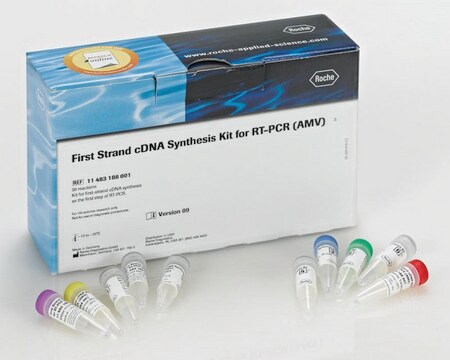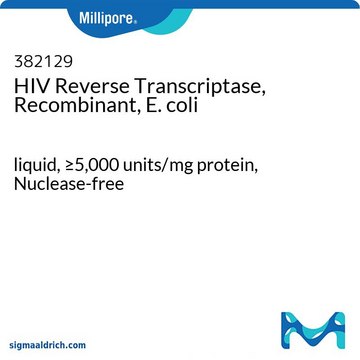M1302
M-MLV Reverse Transcriptase
Moloney Murine Leukemia Virus enzyme & buffer for cDNA synthesis
Synonyme(s) :
Moloney Murine Leukemia Virus Reverse Transcriptase
About This Item
Produits recommandés
Source biologique
Porcine intestinal mucosa
Niveau de qualité
Produit recombinant
expressed in E. coli
Forme
liquid
Utilisation
sufficient for 200 reactions
sufficient for 250 reactions
Caractéristiques
dNTPs included: no
hotstart: no
Concentration
200 units/μL
Technique(s)
RT-PCR: suitable
Couleur
colorless
Entrée
purified RNA
Conditions d'expédition
wet ice
Température de stockage
−20°C
Description générale
Application
- for the preparation of cDNA libraries or for first strand cDNA synthesis
- for use in a 2-step RT-PCR assay
- in quantitative realtime-polymerase chain reaction (RT-qPCR)
- in reverse transcription
Caractéristiques et avantages
- Thermostable reverse transcriptase active at 37 °C.
- Can be used to generate first strand cDNA of up to 7 kb.
Conditionnement
Définition de l'unité
Notes préparatoires
Informations légales
Inhibiteur
Produit(s) apparenté(s)
Mention d'avertissement
Danger
Mentions de danger
Conseils de prudence
Classification des risques
Resp. Sens. 1
Code de la classe de stockage
12 - Non Combustible Liquids
Classe de danger pour l'eau (WGK)
WGK 3
Point d'éclair (°F)
Not applicable
Point d'éclair (°C)
Not applicable
Équipement de protection individuelle
Eyeshields, Gloves, multi-purpose combination respirator cartridge (US)
Certificats d'analyse (COA)
Recherchez un Certificats d'analyse (COA) en saisissant le numéro de lot du produit. Les numéros de lot figurent sur l'étiquette du produit après les mots "Lot" ou "Batch".
Déjà en possession de ce produit ?
Retrouvez la documentation relative aux produits que vous avez récemment achetés dans la Bibliothèque de documents.
Les clients ont également consulté
Articles
The introduction of small interfering RNAs (siRNAs) into cultured cells provides a fast and efficient means of knocking down gene expression and has allowed siRNAs to quickly become a ubiquitous tool in molecular biology.
Introduction of small interfering RNAs (siRNAs) into cultured cells provides a fast and efficient means of knocking down gene expression and has allowed siRNAs to quickly become a ubiquitous tool in molecular biology.
One approach to the analysis of gene expression is to measure the concentration of mRNA of a gene. There are several challenges to such analyses, such as the differences in half life between different transcripts, the temporal patterns of transcription and the lack of correlation between mRNA and protein.
Contenu apparenté
RT-qPCR, or quantitative reverse transcription PCR, combines the effects of reverse transcription and quantitative PCR or real-time PCR to amplify and detect specific targets. RT-qPCR has a variety of applications including quantifying gene expression levels, validating RNA interference (RNAi), and detecting pathogens such as viruses.
Notre équipe de scientifiques dispose d'une expérience dans tous les secteurs de la recherche, notamment en sciences de la vie, science des matériaux, synthèse chimique, chromatographie, analyse et dans de nombreux autres domaines..
Contacter notre Service technique











